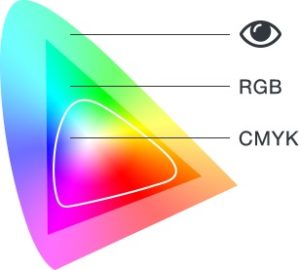RGB & CMYK colour models
approx. reading time: 3 mins
- Drawing
The most well-known colour models are RGB, used for example in digital photography, and CMYK, used for colour printing, and today we’re going to learn more about these two basic colour models. In addition, we’ll cover basic information about their colour modes, depths and gamuts.
1. Colour models
Color models define the range of colors displayed in a given color mode.
In addition to RGB and CMYK based colour mixing models, there are other models that work with brightness and other parameters, such as HSB or Lab. RGB, CMYK or HSB colour models can be thought of as abstract mathematical models describing the numerical representation of colours in a digital image.
1.1 RGB colour model
The RGB (red-green-blue) color model is an additive color model in which red, green, and blue light are mixed together in different ways to reproduce the comprehensive array of colors used in color monitors.
1.2 The CMYK colour model
The CMYK (Cyan-Magenta-Yellow-Key(Black)) or cyan-purple-yellow-black colour model is a colour model based on subtractive colour mixing. It is mainly used in reproduction devices that create colours by mixing pigments. Previously, the CMY colour model was used, where black was achieved by mixing the other colours, but this black was not of very high quality, so now the CMYK model is used, where a fourth colour, black, is added. Adding this extra colour reduces the cost of printing.
Colour gamut
All colors expressed in RGB cannot be displayed in CMYK and vice versa. This is due to different colour gamuts. Therefore, when printing photos, colour brilliance may be lost – the colours on the monitor will look different from the colours on the paper.

2. Colour modes
Color modes determine how colors are combined based on the number of channels in the color model. Different color models result in different levels of color detail and file sizes.
2.1 RGB colour mode
RGB color mode uses an RGB model that assigns an intensity value to each pixel. In images with 8 bits per channel, the intensity values range from 0 (black) to 255 (white) for each of the RGB components (red, green, blue) in the color image.
2.2 CMYK colour mode
In CMYK mode, each pixel is assigned a percentage value for each print color extraction. The lightest colors (highlights) are assigned small percentage values for the print colors; darker colors (shadows) are assigned higher values. For example, a bright red may contain 2% cyan, 93% magenta, 90% yellow, and 0% black. In CMYK images, pure white is produced when all four components have values of 0%.
Colour depths
Determine how many colors are possible in an image, black and white (1 bit color depth is theoretically sufficient), grayscale (8 or 16 bits), RGB (24 or 48 or 96 bits), Lab (24 bits), CMYK (32 bits).


